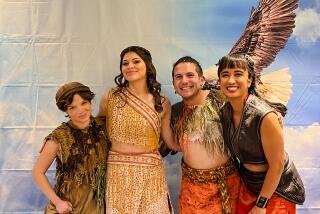East Meets West in Kabuki-Style ‘Jesus Christ Superstar’ : * Stage: A Japanese version of the English musical is getting attention in London. It marks the first time the production has been staged outside Japan.
- Share via
LONDON — Surrounded by his followers, Jesus Christ appears wearing Kabuki whiteface and a vaguely hippie-style net shirt. To the sound of an electric guitar and Asian rhythm instruments, he steps gently across a row of wooden Japanese wagons and makes his way to the center of a stark, angled stage.
As the musical story of Jesus’ last seven days unfolds, the stage swells with incongruous images and sounds: geishas and apostles, parasols and crosses, gentle Japanese strings and honky-tonk piano.
One of Japan’s largest theater companies has brought to London its Kabuki-style, Japanese-language production of the Andrew Lloyd Webber-Tim Rice musical “Jesus Christ Superstar.” Although the Shiki Theatrical Company of Tokyo has been staging the production in Japan for 18 years, it has never been performed outside Japan before.
Despite the barrier presented by the Japanese language and much of the audience’s unfamiliarity with the Kabuki tradition, taking one of the stories most central to Western culture, wrapping it in an Eastern milieu, and returning it to the West seems to have struck a positive chord here.
“It is the best production of ‘Jesus Christ Superstar’ I’ve ever seen,” Lloyd Webber said at a cast party that followed Tuesday’s opening night performance. “It’s what we should have opened with in America 20 years ago. And I mean that.”
The production, which will run in London for one week only, was brought over as part of a massive Japan Festival in Great Britain, which began this month and will continue through January. The celebration of one island nation’s culture by another will encompass 350 events at 200 venues across Great Britain. The festival includes numerous museum exhibits displaying Japanese art, photography, design, sculpture and crafts and a look at state-of-the-art robots at the Science Museum. Major film festivals are planned and the Institute of Contemporary Arts is hosting a season of Japanese video art.
British television and radio stations are crammed with programs from, and about, Japan, and an array of theatrical productions are scheduled. A five-day sumo wrestling tournament will be held next month at the Royal Albert Hall, marking the first time in 1,500 years, festival organizers say, that an official sumo tournament has been held outside Japan.
But so far, less than two weeks into the five-month extravaganza, two Japanese theater productions have garnered most of the attention--”Jesus Christ Superstar” and “Hamlet,” also performed Kabuki-style. The British have been fascinated--and occasionally skeptical--at the notion of seeing their plays radically transformed and sent back to them.
Japanese officials involved in the festival have said that they wanted to include works that reflected the ways in which the Japanese incorporate Western culture into their own.
Keita Asari, who founded the Shiki (Four Seasons) Theatrical Company of Tokyo in 1953 and directed the production of “Jesus Christ Superstar,” said he was particularly interested in adapting this musical “because Christianity is the essence of Western culture” and he wanted to “create a fusion and collision of East and West.”
The Shiki stages 1,000 performances a year and keeps more than 200 actors on the payroll.
The company’s range of productions and styles includes everything from children’s theater, where Asari’s actors must prove themselves, to traditional Japanese theater to French classical to such Broadway and West End blockbusters as “West Side Story,” “Evita,” “Cats” and “Phantom of the Opera.”
In Asari’s production of “Superstar,” some Kabuki conventions are not adhered to, leaving space to incorporate the framework of the original. For example, where traditional Kabuki theater does not include women actors, this production does. To vary the settings on his stark stage, the director chose to use five daihachi guruma , traditional Japanese wagons, which were repositioned for each new scene. Although the wagons have no historical role in Kabuki theater, they created a sense of the Japanese setting.
The storyline follows the original, telling the tale of the last seven days of Christ’s life, mostly through the eyes of Judas. The music remains the same, albeit with Japanese instruments mixed into the rock score.
In some scenes, Asari blends both cultures: When King Herod arrives to test Jesus’ claim that he is the son of God, Herod appears as a transvestite in a luxurious kimono and, with a rickshaw waiting behind him, he twirls a fan as he sings.
When Jesus is arrested by the Romans, soldiers dressed as ancient Japanese warriors lead him away. When Jesus is nailed to the cross, the white-faced mob beneath him forms a cross-hatch pattern with bamboo rods, which creates dozens of crosses.
The show, which began life as a rock-opera album, debuted on Broadway in October, 1971. It opened in London in August, 1972, where it played for nine years, the longest-running West End musical until “Cats” scratched its record. There have been official productions of the show in 38 countries.
There are no immediate plans to take the Kabuki version of “Jesus Christ Superstar” elsewhere, but Andrew Fell, the British theater producer who brought the show to London, said that if it proves successful this week, there is a possibility it may be staged in the United States.
Trevor Nunn, who directed the original production of “Cats” and is considered one of Britain’s most prominent stage directors, thought the production worth a world tour.
“I enjoyed it a great deal,” he said as he left the theater. “It proves that Andrew’s work is truly international. Whoever had the idea of bringing ‘Jesus Christ Superstar’ to the Japan Festival has been vindicated.”
More to Read
The biggest entertainment stories
Get our big stories about Hollywood, film, television, music, arts, culture and more right in your inbox as soon as they publish.
You may occasionally receive promotional content from the Los Angeles Times.










